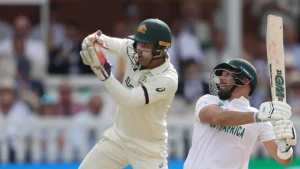
Dr AIi Bacher turned 83 last month. For one golden southern summer 55 years ago, he captained what was then undoubtedly the strongest Test side in the world, boasting talents like Graeme Pollock, Barry Richards, Eddie Barlow, Mike Procter and Peter Pollock. But because of the South African government’s Apartheid policy, which had led to them being outlawed from the Olympic movement – and would soon see them isolated in the cricket world as well – they could never prove their might against countries like India and Pakistan.
The 4-0 thrashing of a formidable Australian side would be South Africa’s last act in international cricket for over two decades.
Since readmission in 1991 – Jagmohan Dalmiya and India played the pivotal role in that – South African cricket has often had to negotiate political minefields based on the racial composition of the side. Omar Henry was a token Coloured face in those early tours, while Makhaya Ntini became the first black cricketer of note in the late 1990s. But whether it was Hashim Amla, with roots in Gujarat, or the likes of Temba Bavuma -captaining the side in this World Test Championship (WTC) final – they had to work twice as hard to get past the whispers, and occasional yells, of ‘quota player’.
What we’ve seen at Lord’s is the full power of the Rainbow Nation that the late Nelson Mandela envisaged. The term itself was coined by the Desmond Tutu, the late Archbishop of Cape Town and anti-apartheid activist. Kagiso Rabada, who took the five-for in the first innings, and Lungi Ngidi, who broke the game open with the wicket of Steve Smith in the second, are both black, like their captain. Keshav Maharaj, who triggered Australia’s first innings collapse with the wicket of Alex Carey, is of Indian origin. As for the white contingent, there are both English and Afrikaans speakers.
In the past, there was often a clear divide based on race. You could see that in the dining rooms and bars after play, with each group taking its own space. But the transformative effect of two successive Rugby World Cup wins – both captained by Siya Kolisi, a black man from the Eastern Cape – has clearly impacted other sports as well. This South African team know they’re only as strong as their weakest link, and they seem to look out for each other.
In that sense, there was real poetry in the 35-year-old Bavuma, batting with a damaged hamstring, and Aiden Markram – five years his junior, who could succeed him as captain – adding 143 unbroken runs to put South Africa in charge of the final. There was no black or white at Lord’s on Friday evening, just two proud South Africans looking to set right a catalogue of misadventures in major tournaments.
Barlow, who died nearly 20 years ago, was one of those who campaigned hard for people of colour to get their due, but he never got to play an international game alongside the great Coloured all-rounder of that time – Sulaiman ‘Dik’ Abed. And while many mourn the aborted careers of Pollock, Barlow, Richards, Clive Rice and others, few spare a thought for Abed and dozens of others who never got to wear their country’s cap because of Apartheid.
Some, like the brilliant Basil D’Oliveira, emigrated and played elsewhere – for England, in his case – while others like the outstanding Sedick “Dickie” Conrad, one of the great opening batsmen of his day, were hardly known to the outside world. Sedick passed away last March, but his son, Shukri, is now the coach poised to end the Proteas’ global-title drought.
On Saturday, with an hour or more of determined batting, South Africa can push that dark passage in the country’s history to the back pages. This is a new team, and what seems like a fresh start. From the token Henry to a black captain poised to lift the Test mace, it’s been a long and eventful journey.




